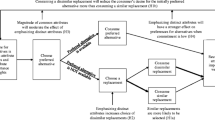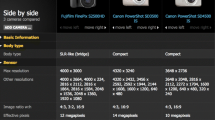Abstract
A new brand entering a market often finds itself in competition with sibling brands (those owned by the same parent company). In a case study of a retail coffee market, the authors examine how these brand relationships might influence the sibling and competitor brands' responses to entry. Using an empirically validated brand-share attraction model, the authors compare the actual responses to entry with the optimal responses under different incumbent objectives. The authors find that the responses by sibling brand are more accommodating than those of unrelated brands whose responses are consistent with the preservation of preentry levels of sales.
Similar content being viewed by others
References
Bell, Stephen S. and Gregory S. Carpenter. 1992. “Optimal Multiple Objective Marketing Strategies.” Marketing Letters 3 (4): 383–393.
Blattberg, Robert C. and Kenneth J. Wisniewski. 1989. “Price-Induced Patterns of Competition.” Marketing Science 8 (Fall): 291–309.
—, Thomas Buesing, and Subrata K. Sen. 1980. “Segmentation Strategies for New National Brands.” Journal of Marketing 44 (Fall): 59–67.
Bowman, Douglas and Hubert Gatignon. 1996. “Order of Entry as a Moderator of the Effect of the Marketing Mix on Market Share.” Marketing Science 15 (3): 222–242.
Cooper, Lee G. and Masao Nakanishi. 1988. Market Share Analysis. Boston: Kluwer.
Deshpande, Rohit and Hubert Gatignon. 1994. “Competitive Analysis.” Marketing Letters 5 (3): 271–287.
Fanelli, Louis A. 1981. “GF sends Master Blend Into Battle.” Advertising Age, January 26, pp. 1, 76.
Federal Trade Commission (FTC). 1984. In the Matter of General Foods Corporation. 103 F.T.C. Washington, DC: Federal Trade Commission.
Fraser, Cynthia and John W. Bradford. 1983. “Competitive Market Structure Analysis: Principal Partitioning of Revealed Substitutabilities.” Journal of Consumer Research 10 (June): 15–30.
Gordon, Richard L. 1982. “FTC Judge OKs GF Defense vs. Folger.” Advertising Age, February 8, p. 6.
Grover, Rajiv and V. Srinivasan. 1987. “A Simultaneous Approach to Market Structuring and Segmentation.” Journal of Marketing Research 24 (May): 139–153.
Gruca, Thomas S. 1989. “Optimal Competitive Marketing Response to Entry: Theoretical And Empirical Analyses.” Ph.D. dissertation. University of Illinois at Urbana-Champaign.
—, Wylbur Moulton, and D. Sudharshan. 1987. “Market Structure Analysis: A Boolean Factor Analytic Approach and Empirical Example.” In 1987 AMA Educators' Proceedings, Vol. 53. Eds. M. R. Solomon and Susan P. Douglas. Chicago: American Marketing Association, 108–111.
—, K. Ravi Kumar, and D. Sudharshan. 1992. “An Equilibrium Analysis of Defensive Response to Entry Using a Coupled Response Function Model.” Marketing Science 11 (4): 348–358.
—, D. Sudharshan, and K. Ravi Kumar. 2001. “Marketing Mix Response to Entry in Segmented Markets.” International Journal of Research in Marketing 18 (1/2): 53–66.
Gupta, Sunil. 1988. “Impact of Sales Promotion on When, What and How Much to Buy.” Journal of Marketing Research 25 (November): 342–55.
Hauser, John R. and Steven M. Shugan. 1983. “Defensive Marketing Strategies.” Marketing Science 2 (Fall): 319–360.
Jeffrey, Don. 1994. “Managing the Budget.” Billboard 106 (37): 53–56.
Lehmann, Donald R. 1972. “Judged Similarity and Brand-Switching Data as Similarity Measures.” Journal of Marketing Research 9 (August): 331–334.
Lohr, Steve. 1981. “Strategy Shift at General Foods.” New York Times, March 2, sec. D, p. 1, col. 3.
Madden, Paul. 1986. Concavity and Optimization in Microeconomics. London: Basil Blackwell.
Maxwell, John C. 1982. “Coffee Sales Slide May Level off.” Advertising Age, April 12, p. 62.
Moore, William L. and Russel S. Winer. 1987. “A Panel-Data Based Method for Merging Joint Space and Market Response Function Estimation.” Marketing Science 6 (Winter): 25–42.
Naert, Philippe A. and Marcel Weverbergh. 1981. “On the Prediction Power of Market Share Attraction Models.” Journal of Marketing Research 18 (May): 146–153.
Nakanishi, Masao and Lee G. Cooper. 1974. “Parameter Estimation for a Multiplicative Competitive Interaction Model—Least Squares Approach.” Journal of Marketing Research 11 (August): 303–311.
O'Connor, John. 1979. “GF Tries Economy Area With Master Blend Brew.” Advertising Age, January 27, pp. 1, 82.
Osborne, Dale K. 1964. “On the Goals of the Firm.” Quarterly Journal of Economics 78 (4): 592–603.
Reis, Paul N. 1987. “Comment on ‘A Panel-Data Based Method for Merging Joint Space and Market Response Function Estimation.” Marketing Science 6 (Winter): 44–45.
Rossiter, John R. and Larry Percy. 1987. Advertising and Promotion Management. New York: McGraw-Hill.
Rozen, Leah. 1980. “Coffee Prices Hurt Economy Brands.” Advertising Age, February 11, pp. 1, 24.
Saporito, Bill. 1986. “Has-Been Brands Go Back to Work.” Fortune, April 28, pp. 123–124.
—. 1990. “Can Anyone Win the Coffee War?” Fortune, May 21, pp. 97–98.
Schiller, Zachary. 1988. “The Marketing Revolution at Procter and Gamble.” Business Week, July 25, pp. 72–76.
Shaw, R. W. 1982. “Product Proliferation in the Characteristics Space: The UK Fertilizer Industry.” Journal of Industrial Economics 31 (1/2): 69–91.
Tversky, Amos and Daniel Kahnemann. 1974. “Judgment Under Uncertainty.” Science 185: 1124–1131.
Author information
Authors and Affiliations
Additional information
Thomas S. Gruca (Ph.D., University of Illinois) is a Lloyd J. and Thelma W. Palmer Research Fellow and an associate professor of marketing in the Tippie College of Business at the University of Iowa. His research on defensive marketing strategy has appeared in the International Journal of Research in Marketing, the Journal of Marketing, the Journal of Marketing Research, Marketing Management, and Marketing Science. His research on health care has appeared in Contemporary Accounting Research, Health Care Management Science, and Strategic Management Journal. He is currently working on electronic prediction markets and modeling hospital network formation. He is a member of the editorial board of Marketing Letters and a reviewer for a number of management science journals.
D. Sudharshan (Ph.D., University of Pittsburgh) is a professor of business administration in the College of Commerce and Business Administration at the University of Illinois at Urbana-Champaign. His research interests lie in the areas of marketing strategy, new product and service development, and marketing technology management. He serves on the editorial boards of the Journal of Marketing and the Journal of the Academy of Marketing Science. His articles have appeared in various journals including Marketing Science, Management Science, the Journal of Marketing, the Journal of Marketing Research, the Strategic Management Journal, the European Journal of Operational Research, the Journal of Service Research, and the Journal of Market Focused Management.
K. Ravi Kumar (Ph.D., Northwestern University) is a professor in the Department of Information and Operations Management, Marshall School of Business, at the University of Southern California. His current research interests include the embedding of information systems within global physical operation and the development of sustainable information technology industries in developing countries. He is the author or coauthor of articles appearing in Management Science, Marketing Science, the Journal of Economic Theory, Production and Operations Management, and the Journal of Operations Management. He serves on the advisory boards of Production and Operations Management and Technology and Operations Review.
Rights and permissions
About this article
Cite this article
Gruca, T.G., Sudharshan, D. & Kumar, K.R. Sibling brands, multiple objectives, and response to entry: The case of the marion retail coffee market. J. of the Acad. Mark. Sci. 30, 59–69 (2002). https://doi.org/10.1177/03079459994326
Issue Date:
DOI: https://doi.org/10.1177/03079459994326




